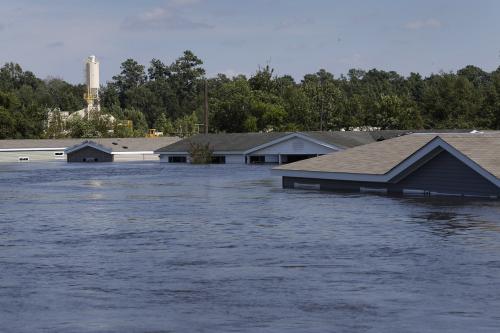America is facing a water infrastructure crisis.
From overwhelmed sewers in Houston to leaking pipes in Chicago to water main breaks in Boston, the scale is national, and the challenge is growing. Local water utilities face billions of dollars in costs to replace pipes, upgrade plants, and address other failures in their systems, all while dealing with increasingly extreme storms and mounting concerns regarding water quality and quantity.
Investing more in the country’s water infrastructure would help—which the Trump administration and other federal leaders appear to be considering in 2018—but simply throwing more money at these problems does not necessarily address another enormous challenge facing utilities and the communities they serve: water affordability.
To keep up with mounting infrastructure costs, utilities have been scrambling to generate more revenue. And in many places, that has meant significantly higher water rates for households, with the average monthly residential bill rising by nearly 50 percent since 2010 and far faster than incomes. As those rates rise, water affordability becomes a core issue—not just in specific cities like Flint, but for lower-income households in all types of regions.
With states and localities responsible for more than 95 percent of public spending on water infrastructure each year, it’s not surprising that conversations concerning water investment and affordability often start and end at a regional level. However, at a moment when infrastructure is gaining more national visibility, federal leaders have an opportunity to provide greater policy direction and financial support.
They can do so in two primary ways: (1) by establishing clearer metrics and guidelines for utilities as they strive for more reliable, affordable service, and (2) by offering additional financial and technical support for utilities to develop customer assistance programs.
The first federal strategy would mark a crucial step in defining the extent of the affordability challenge nationally, including greater consistency in monitoring and addressing it. Since the nation’s 52,000 water utilities are so highly localized and fragmented, they can struggle to measure what water affordability means in their communities and develop strategies in support of more affordable service. At the same time, utilities may not always weigh their revenue needs alongside broader equity concerns when considering rate adjustments, including the effects on customers across all income levels.
Investing more in the country’s water infrastructure would help (…) but simply throwing more money at these problems does not necessarily address another enormous challenge facing utilities and the communities they serve: water affordability.
While some utilities are already taking the lead to improve their asset management and better quantify water affordability, many others are not. Instead, utilities may follow what little guidance exists at the federal level, namely from the U.S. Environmental Protection Agency (EPA), which narrowly and inaccurately focuses on water bills as a share of median household income (MHI). For instance, according to current EPA guidance, combined drinking water and wastewater bills are affordable if they do not exceed 4.5 percent of MHI; however, that may not be the case in reality, particularly for lower-income households.
This approach has increasingly come under fire among academics and practitioners alike, and the time is ripe for federal leaders—in EPA and Congress—to devise a new approach.
A recent congressionally-directed report from the National Academy of Public Administration has offered some practical recommendations, including the need to consider a broad range of social and economic concerns to gauge water affordability in different neighborhoods. Likewise, the House and Senate have introduced bills to more clearly articulate the types of metrics, tools, and policy frameworks that will help communities provide more affordable water. EPA needs to finalize and implement new guidelines, working in concert with utilities, researchers, and other local groups in their development.
The second federal strategy—focused on customer assistance programs—would help build additional financial capacity for utilities as they look to accelerate their affordability efforts. CAPs, in short, are utility-sponsored programs aimed at helping lower-income customers pay their water bills, and have taken on greater importance in several cities, including Philadelphia, Washington, and Detroit. In some cities like Baltimore, CAPs can represent a lifeline to customers who may even lose their homes after falling behind on their water bills.
However, the creation and proliferation of CAPs remains slow and uneven across the country. For example, utilities often form CAPs on an ad-hoc basis with minimal guidance or financial support. Meanwhile, some states have legal barriers in place that preempt the local formation of CAPs. Finally, while EPA provides technical resources regarding CAPs and has partnered with communities in support of greater financial capacity, little federal action appears elsewhere to strengthen CAPs.
Congress, in particular, is well-positioned to provide more robust support for CAPs. Although some isolated proposals have emerged over the past couple years addressing CAPs, they have not gained traction up to this point; over the coming months, however, renewed conversations on federal infrastructure investment may provide an opportunity to re-consider these ideas. Models from other sectors, such as the Low Income Home Energy Assistance Program, would offer a good place to start. While LIHEAP depends on annual appropriations to the U.S. Department of Health and Human Services, which then distributes funding to states, developing and applying a similar approach for targeted water assistance could work.
Undertaking all of these steps, of course, is easier said than done, and federal leaders will not be able to address the country’s water affordability challenge by themselves. The nuance of this challenge ultimately depends on local action; utilities, along with other civic and community partners, need to carefully evaluate affordability concerns in their own markets, as they consider different types of financial assistance and rate adjustments.[i]
However, the federal role should not be easily dismissed either, particularly as Congress considers more infrastructure investment and, ideally, develops a vision for how infrastructure can support greater economic opportunity. An influx of federal funding for water infrastructure—through targeted project support, state revolving funds, or the nascent WIFIA program—would help reduce the financial burden many utilities are confronting and shifting to their ratepayers. Beyond additional direct financial support, federal leaders can also establish a clearer national policy direction and make it easier for utilities and communities to pioneer new programs in support of affordable water.
[i] For more background on new ways in which cities are measuring water affordability and considering rate adjustments, see this excellent analysis by Manny Teodoro from Texas A&M.
The Brookings Institution is committed to quality, independence, and impact.
We are supported by a diverse array of funders. In line with our values and policies, each Brookings publication represents the sole views of its author(s).







Commentary
Water affordability is not just a local challenge, but a federal one too
January 25, 2018